Composition Explained: Techniques for Photography Beginners
Most beginner photographers struggle with composition. These tips will help you get started the right way.
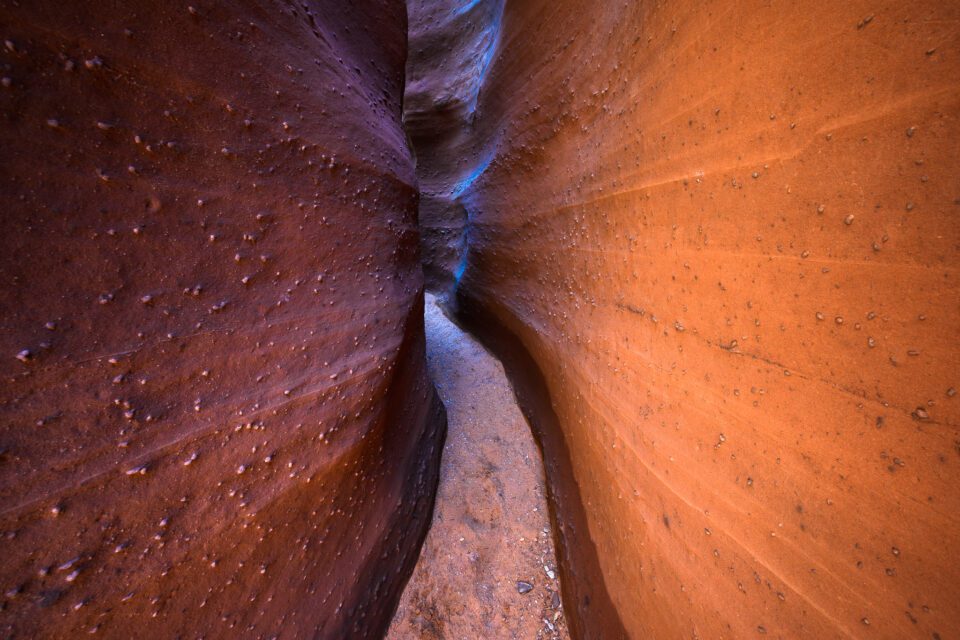 NIKON Z 7 + NIKKOR Z 14-30mm f/4 S @ 14mm, ISO 400, 1/6, f/13.0
NIKON Z 7 + NIKKOR Z 14-30mm f/4 S @ 14mm, ISO 400, 1/6, f/13.0
Composition is critical. If you want to take powerful photos, it’s one of the most important parts of photography. Still, a lot of photographers start out only hearing about the rule of thirds, and they never go more in-depth on how to compose better photos. The good news is that you can learn more about composition – and you should. It’s a deep topic, and there’s no way to cover everything in just one article, but I’ll do my best to hit the biggest points below, in this chapter of our Photography Basics guide.
شرح التركيب: تقنيات للمبتدئين في التصوير الفوتوغرافي
يواجه معظم المصورين المبتدئين صعوبة في التكوين. ستساعدك هذه النصائح على البدء بالطريقة الصحيحة.
كاميرا NIKON Z 7 + NIKKOR Z مقاس 14-30 مم f/4 S @ 14 مم، ISO 400، 1/6، f/13.0
التكوين أمر بالغ الأهمية. إذا كنت تريد التقاط صور قوية، فهذا أحد أهم أجزاء التصوير الفوتوغرافي. ومع ذلك، يبدأ الكثير من المصورين في السماع عن قاعدة الأثلاث فقط، ولا يتعمقون أبدًا في كيفية تكوين صور أفضل. والخبر السار هو أنه يمكنك معرفة المزيد حول التكوين – ويجب عليك ذلك. إنه موضوع عميق، ولا توجد طريقة لتغطية كل شيء في مقالة واحدة فقط، ولكنني سأبذل قصارى جهدي للوصول إلى أهم النقاط أدناه، في هذا الفصل من دليل أساسيات التصوير الفوتوغرافي.
Table of Contents
- What is Composition?
- The Elements of Composition
- Intent
- Simplicity
- Balance
- Breathing Space
- Positive and Negative Space
- Patterns and Relationships
- Conclusion
- جدول المحتوياتما هو التكوين؟
عناصر التكوين
، القصد،
البساطة، التوازن
، مساحة التنفس،
الفضاء الإيجابي والسلبي،
الأنماط والعلاقات
، الخاتمة - What is Composition?Composition is the structure of a photograph. It’s how you arrange the elements in your image to create the look you want, and it can make or break an image. If you stumble upon an interesting subject — no matter how good the light is, or how unusual the conditions are — you still need to compose the photo well if you want a successful result.
You have an absurd amount of power to change the composition of a photo. Move forwards and backwards, left and right. Change your lens — zoom in, zoom out. And pay attention to which elements of the scene you’re including, as well as the ones you’re not. Done right, composition takes your subject and presents it to your viewers as effectively as possible. It is the mechanism for conveying a message with your photos.
 NIKON D7000 + 24mm f/1.4 @ 24mm, ISO 250, 1/200, f/7.1
NIKON D7000 + 24mm f/1.4 @ 24mm, ISO 250, 1/200, f/7.1
I chose this composition very carefully to frame the crab between the pieces of grass. - ما هو التكوين؟التركيب هو هيكل الصورة. إنها كيفية ترتيب العناصر في صورتك لإنشاء المظهر الذي تريده، ويمكن أن تؤدي إلى إنشاء صورة أو كسرها. إذا عثرت على موضوع مثير للاهتمام – بغض النظر عن مدى جودة الإضاءة أو مدى غرابة الظروف – فلا تزال بحاجة إلى تكوين الصورة جيدًا إذا كنت تريد نتيجة ناجحة.
لديك قدر لا يصدق من القدرة على تغيير تكوين الصورة. التحرك إلى الأمام والخلف، اليسار واليمين. قم بتغيير عدستك – قم بالتكبير والتصغير. وانتبه إلى عناصر المشهد التي تقوم بتضمينها، وكذلك العناصر التي لا تقوم بتضمينها. إذا تم ذلك بشكل صحيح، فإن التركيب يأخذ موضوعك ويقدمه للمشاهدين بأكبر قدر ممكن من الفعالية. إنها آلية إيصال الرسالة بصورك.
NIKON D7000 + 24 مم f/1.4 @ 24 مم، ISO 250، 1/200، f/7.1
لقد اخترت هذه التركيبة بعناية شديدة لتأطير السلطعون بين قطع العشب. - The Elements of Composition
Points, lines, and shapes.
At the most fundamental level, those are the elements of composition. Anything in your image – your subject, the background, tiny details that don’t even matter – are all points, lines, and shapes. Some of them are very complex, of course. A face or a tree clearly are not simple things. But they still have a shape, and they can help form the structure of an image.
On top of individual elements in a photo, there’s also the way they interconnect with one another. Several elements of a photo, arranged properly, are stronger than the sum of their parts.
To make this clearer, take a look at the photos below. These are side-by-side comparisons of a successful photograph along with its component parts. The first example is a photo from Yosemite. Based solely on the line drawing, you can see that the composition is very balanced, with equal amounts of interest on both halves of the frame. Drag the slider back and forth to see the before/after comparison:


The next photo, from Death Valley, has a more dynamic composition, with strong diagonals running the length of the photo:


Last is a photo from Jökulsárlón in Iceland, with a block of ice washing ashore. Here, you can see the lines and shapes that form the structure of the photo:


To me, the interesting thing so far is that these three line drawings still work well on their own, and they maintain a similar emotional mood as the original image. I wouldn’t hang them on my wall, of course — but they have a certain internal structure, even as simple as they are.When I’m out taking photos, do I actually imagine my subject as a set of black-and-white lines? I’d be lying if I said that I did. What I do think about, though, is arranging a good structure — which, deep down, has its roots in fundamental elements like lines and shapes.
- عناصر التكوين
النقاط والخطوط والأشكال.
على المستوى الأساسي، هذه هي عناصر التكوين. أي شيء في صورتك – الموضوع، الخلفية، التفاصيل الصغيرة التي لا تهم – كلها نقاط وخطوط وأشكال. بعضها معقد للغاية بالطبع. من الواضح أن الوجه أو الشجرة ليست أشياء بسيطة. ولكن لا يزال لديهم شكل، ويمكنهم المساعدة في تكوين بنية الصورة.
علاوة على العناصر الفردية في الصورة، هناك أيضًا الطريقة التي تترابط بها مع بعضها البعض. العديد من عناصر الصورة، إذا تم ترتيبها بشكل صحيح، تكون أقوى من مجموع أجزائها.
ولتوضيح الأمر أكثر، ألق نظرة على الصور أدناه. هذه مقارنات جنبًا إلى جنب للصورة الناجحة مع الأجزاء المكونة لها. المثال الأول هو صورة من يوسمايت. استنادًا إلى الرسم الخطي فقط، يمكنك أن ترى أن التركيبة متوازنة جدًا، مع قدر متساوٍ من الاهتمام على نصفي الإطار. اسحب شريط التمرير ذهابًا وإيابًا لرؤية المقارنة قبل/بعد:


الصورة التالية، من وادي الموت، لها تركيبة أكثر ديناميكية، مع خطوط قطرية قوية تمتد على طول الصورة:

الصورة الأخيرة من جوكولسارلون في أيسلندا، مع كتلة من الجليد تغسل على الشاطئ. هنا، يمكنك رؤية الخطوط والأشكال التي تشكل بنية الصورة:

بالنسبة لي، الشيء المثير للاهتمام حتى الآن هو أن هذه الرسومات الخطية الثلاثة لا تزال تعمل بشكل جيد من تلقاء نفسها، وتحافظ على مزاج عاطفي مماثل للصورة الأصلية. لن أعلقها على حائطي بالطبع، لكن لديها بنية داخلية معينة، حتى مع بساطتها.
عندما أخرج لالتقاط الصور، هل أتخيل فعليًا موضوعي كمجموعة من الخطوط بالأبيض والأسود؟ سأكون كاذبًا إذا قلت أنني فعلت ذلك. لكن ما أفكر فيه هو ترتيب بنية جيدة، والتي لها جذورها في العمق في العناصر الأساسية مثل الخطوط والأشكال.
- Intent
The big secret of composition is not that you should follow one structure or template for a majority of your photos (which is what the rule of thirds suggests). Instead, the important thing is to pick your composition intentionally.
Intent is the most important part of composition. Nothing in the photograph should happen by accident. Everything must have a reason to exist. If you remember that, and you really spend time in the field making it happen, your photos will skyrocket in quality. It’s almost impossible to avoid since you’ll end up putting more conscious thought into how a photo appears.
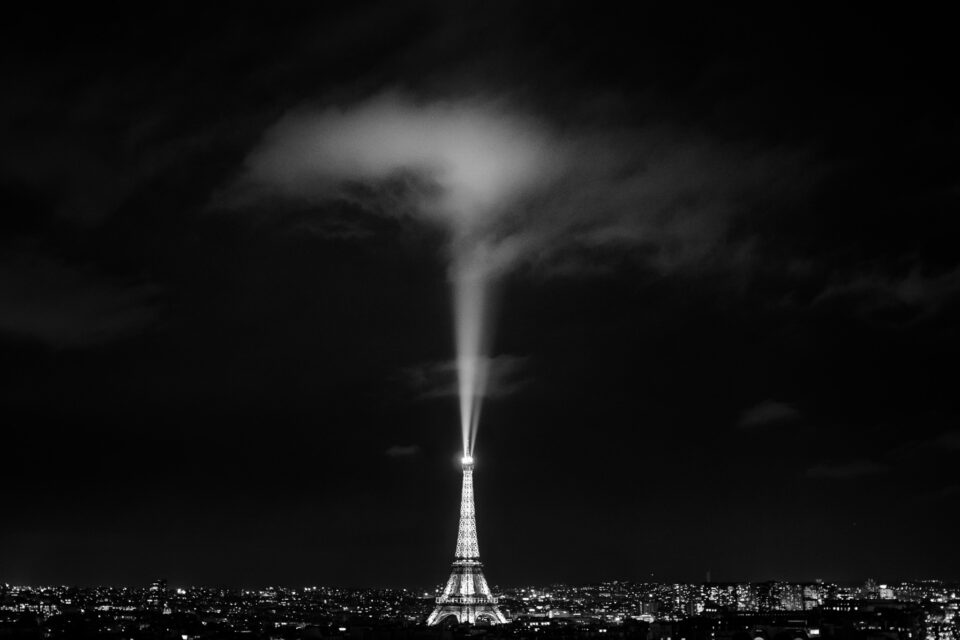 My composition here was highly intentional. I had to wait several minutes and try multiple times in order to capture the spotlight in the right place. Specifically, I needed to wait until the beam of light (which was spinning 360 degrees) pointed directly at me, so that it looked as if it were shining straight up. I didn’t just haphazardly photograph the Eiffel Tower without conscious effort. Instead, I thought of an image in my mind and did everything possible to make it a reality.
My composition here was highly intentional. I had to wait several minutes and try multiple times in order to capture the spotlight in the right place. Specifically, I needed to wait until the beam of light (which was spinning 360 degrees) pointed directly at me, so that it looked as if it were shining straight up. I didn’t just haphazardly photograph the Eiffel Tower without conscious effort. Instead, I thought of an image in my mind and did everything possible to make it a reality. - نية
السر الكبير للتكوين ليس أنه يجب عليك اتباع بنية أو قالب واحد لأغلبية صورك (وهو ما تقترحه قاعدة الثلث). وبدلاً من ذلك، الشيء المهم هو اختيار مقطوعتك الموسيقية عمدًا.
النية هي الجزء الأكثر أهمية في التكوين. لا ينبغي أن يحدث أي شيء في الصورة عن طريق الصدفة. كل شيء يجب أن يكون له سبب لوجوده. إذا تذكرت ذلك، وقضيت وقتًا حقيقيًا في الميدان لتحقيق ذلك، فسترتفع جودة صورك بشكل كبير. يكاد يكون من المستحيل تجنب ذلك نظرًا لأنه سينتهي بك الأمر إلى التفكير بشكل أكثر وعيًا في كيفية ظهور الصورة.
تكويني هنا كان مقصودًا للغاية. اضطررت إلى الانتظار عدة دقائق والمحاولة عدة مرات لالتقاط الأضواء في المكان المناسب. على وجه التحديد، كنت بحاجة إلى الانتظار حتى يشير شعاع الضوء (الذي كان يدور بزاوية 360 درجة) نحوي مباشرة، بحيث يبدو كما لو كان يسطع بشكل مستقيم. لم أقم بتصوير برج إيفل بشكل عشوائي دون بذل جهد واعي. وبدلاً من ذلك، فكرت في صورة في ذهني وبذلت قصارى جهدي لجعلها حقيقة.
- Simplicity
Every photo you take has an emotional message — the core reason why you chose to take a photo in the first place. When you’re out taking pictures, one of the best things you can do is consciously think about the emotional message, and hone in on how you want to express it. That’s where the power of simplicity comes in.
Simplicity means that nothing in your photo takes away from the emotional message. If you’re trying to convey a sense of beauty at a landscape, eliminate everything from the photo that isn’t beautiful. That could be power lines, footprints in the foreground, a piece of trash in the frame, and so on.
At the same time, simplicity also refers to your composition. Don’t overwhelm your viewers with too much information, unless your goal actually is to capture an overwhelming, chaotic photo. When your photo tells the story you want without any distractions, it will be as powerful as possible.
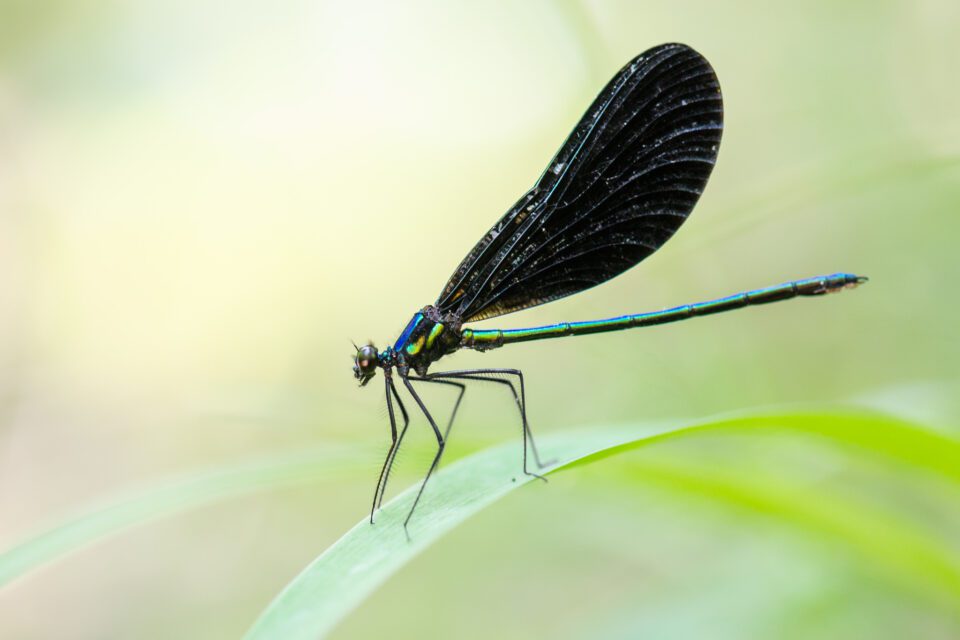 NIKON D7000 + 105mm f/2.8 @ 105mm, ISO 1250, 1/100, f/3.5
NIKON D7000 + 105mm f/2.8 @ 105mm, ISO 1250, 1/100, f/3.5
No element in this photo takes away from my message. Every part exists for a reason. - بساطة
تحتوي كل صورة تلتقطها على رسالة عاطفية – وهو السبب الأساسي وراء اختيارك لالتقاط صورة في المقام الأول. عندما تكون بالخارج لالتقاط الصور، أحد أفضل الأشياء التي يمكنك القيام بها هو التفكير بوعي في الرسالة العاطفية، والتركيز على الطريقة التي تريد بها التعبير عنها. وهنا تكمن قوة البساطة.
البساطة تعني أنه لا يوجد شيء في صورتك ينتقص من الرسالة العاطفية. إذا كنت تحاول نقل إحساس بالجمال في المناظر الطبيعية، فقم بإزالة كل شيء غير جميل من الصورة. يمكن أن يكون ذلك خطوط كهرباء، أو آثار أقدام في المقدمة، أو قطعة من القمامة في الإطار، وما إلى ذلك.
وفي الوقت نفسه، تشير البساطة أيضًا إلى تكوينك. لا تغمر مشاهديك بالكثير من المعلومات، إلا إذا كان هدفك هو التقاط صورة فوضوية ومربكة. عندما تحكي صورتك القصة التي تريدها دون أي تشتيت، ستكون قوية قدر الإمكان.
NIKON D7000 + 105 مم f/2.8 @ 105 مم، ISO 1250، 1/100، f/3.5
لا يوجد عنصر في هذه الصورة يأخذ من رسالتي. كل جزء موجود لسبب ما. - Balance
One of the main things I think about when composing a picture is balance.
Balance is fairly easy. To start, all you need to do is ask yourself how much attention each element in the image attracts. This is known as “visual weight.” Objects that have high levels of visual weight include bright objects, saturated colors, eyes, people, animals, high contrast, and unusual elements — anything that attracts attention in the real world. Then, figure out if the visual weight is distributed evenly across the frame, or if one half of the photo has more than the other (from left to right). If they’re roughly even, it’s a balanced photo. If not, the photo is imbalanced. (Neither is necessarily better than the other.)
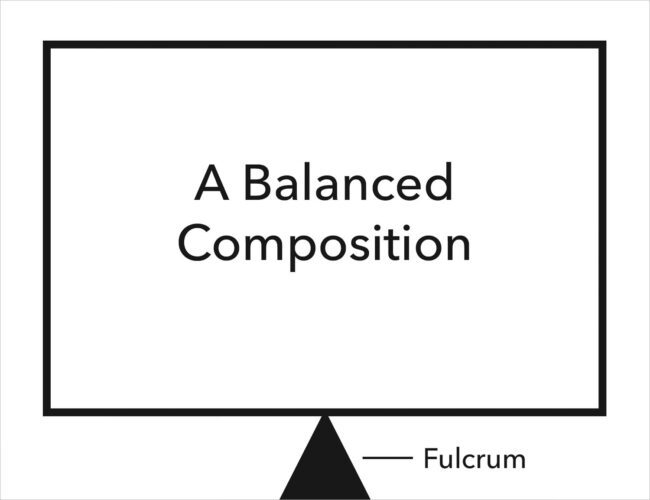 Is your photo balanced? To figure it out, think about the visual weight of every item in your photo. Then, imagine placing the image on a fulcrum. Which direction does it lean?
Is your photo balanced? To figure it out, think about the visual weight of every item in your photo. Then, imagine placing the image on a fulcrum. Which direction does it lean?
This works a lot like a seesaw, including the fact that you can balance a “heavy” object — your main subject — with a “lighter” object, so long as the lighter object is farther to the edge of the photograph (just like balancing a child and an adult on a seesaw). Take a look at the photo below:
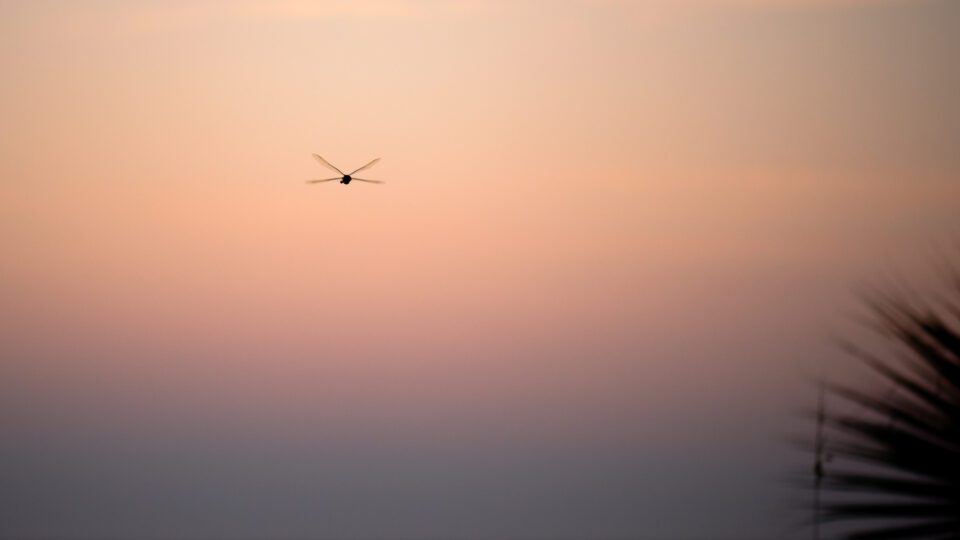 NIKON D800E + 105mm f/2.8 @ 105mm, ISO 400, 1/800, f/2.8
NIKON D800E + 105mm f/2.8 @ 105mm, ISO 400, 1/800, f/2.8
The dragonfly has more visual weight here, while the silhouetted plant in the background has much less. But the plant is right against the edge of the frame, while the dragonfly is nearer to the center. So, overall, this is a balanced photo.
In photography, you have the choice to capture balanced photos or imbalanced photos. Neither is better than the other. What matters is that they both convey different emotions.- Balanced photos are peaceful, static, and calm
- Imbalanced photos are dramatic, tense, and dynamic
If you’re photographing a gentle lake at sunrise, you might not want an imbalanced photo. But, with more intense subjects, it could be the perfect composition. It just depends upon the mood you’re trying to convey.
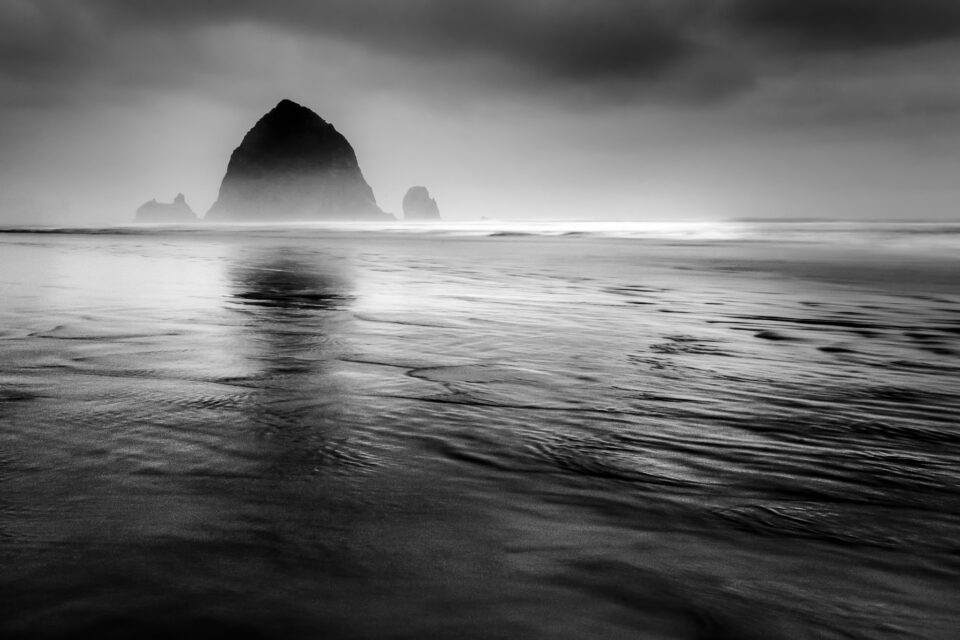 NIKON D5100 + 18-55mm f/3.5-5.6 @ 32mm, ISO 100, 6 seconds, f/22.0
NIKON D5100 + 18-55mm f/3.5-5.6 @ 32mm, ISO 100, 6 seconds, f/22.0
This image is imbalanced to the left. That makes it more dynamic and intense, which works well here. - توازن
أحد الأشياء الرئيسية التي أفكر فيها عند تكوين الصورة هو التوازن.
التوازن سهل إلى حد ما. للبدء، كل ما عليك فعله هو أن تسأل نفسك عن مقدار الاهتمام الذي يجذبه كل عنصر في الصورة. ويُعرف هذا باسم “الوزن البصري”. تشمل الكائنات التي لها مستويات عالية من الوزن البصري الأشياء الساطعة، والألوان المشبعة، والعيون، والأشخاص، والحيوانات، والتباين العالي، والعناصر غير العادية – أي شيء يجذب الانتباه في العالم الحقيقي. بعد ذلك، اكتشف ما إذا كان الوزن المرئي موزعًا بالتساوي عبر الإطار، أو ما إذا كان نصف الصورة يحتوي على أكثر من الآخر (من اليسار إلى اليمين). إذا كانت متساوية تقريبًا، فهي صورة متوازنة. إذا لم يكن الأمر كذلك، فإن الصورة غير متوازنة. (ليس بالضرورة أن يكون أي منهما أفضل من الآخر).
هل صورتك متوازنة؟ لمعرفة ذلك، فكر في الوزن البصري لكل عنصر في صورتك. ثم تخيل وضع الصورة على نقطة ارتكاز. في أي اتجاه يميل؟يعمل هذا إلى حد كبير مثل الأرجوحة، بما في ذلك حقيقة أنه يمكنك موازنة كائن “ثقيل” – موضوعك الرئيسي – مع كائن “أخف وزنًا”، طالما أن الكائن الأخف يقع بعيدًا عن حافة الصورة (تمامًا مثل الموازنة طفل وشخص بالغ على الأرجوحة). ألق نظرة على الصورة بالأسفل:
NIKON D800E + 105 مم f/2.8 @ 105 مم، ISO 400، 1/800، f/2.8
يتمتع اليعسوب بوزن بصري أكبر هنا، في حين أن النبات المظلل في الخلفية له وزن أقل بكثير. لكن النبات يقع على حافة الإطار مباشرةً، بينما اليعسوب أقرب إلى المركز. لذا، بشكل عام، هذه صورة متوازنة.في التصوير الفوتوغرافي، لديك خيار التقاط صور متوازنة أو صور غير متوازنة. لا هو أفضل من الآخر. ما يهم هو أن كلاهما ينقل مشاعر مختلفة.
الصور المتوازنة تكون سلمية وثابتة وهادئة. الصور غير المتوازنة تكون مثيرة ومتوترة وديناميكية
إذا كنت تقوم بتصوير بحيرة لطيفة عند شروق الشمس، فقد لا ترغب في الحصول على صورة غير متوازنة. ولكن، مع مواضيع أكثر كثافة، يمكن أن يكون التكوين المثالي. يعتمد الأمر فقط على الحالة المزاجية التي تحاول نقلها.
NIKON D5100 + 18-55 مم f/3.5-5.6 @ 32 مم، ISO 100، 6 ثوانٍ، f/22.0
هذه الصورة غير متوازنة إلى اليسار. وهذا يجعلها أكثر ديناميكية وكثافة، وهو ما يعمل بشكل جيد هنا. - Breathing Space
When there are multiple points of interest in a photo, you may want to give them “breathing space” by spacing them apart from one another. Otherwise, elements of your photo will interfere with one another (or the edges of your frame), making for a sloppy composition.
Think about a scene where a few birds are flying through the air, and you want to capture all of them in a single photo. If one bird crosses in front of another, though, that area of the image will look messy and unintentional. It’s better, instead, if all your subjects have some space to breathe — between one another, and between the edges of your image.
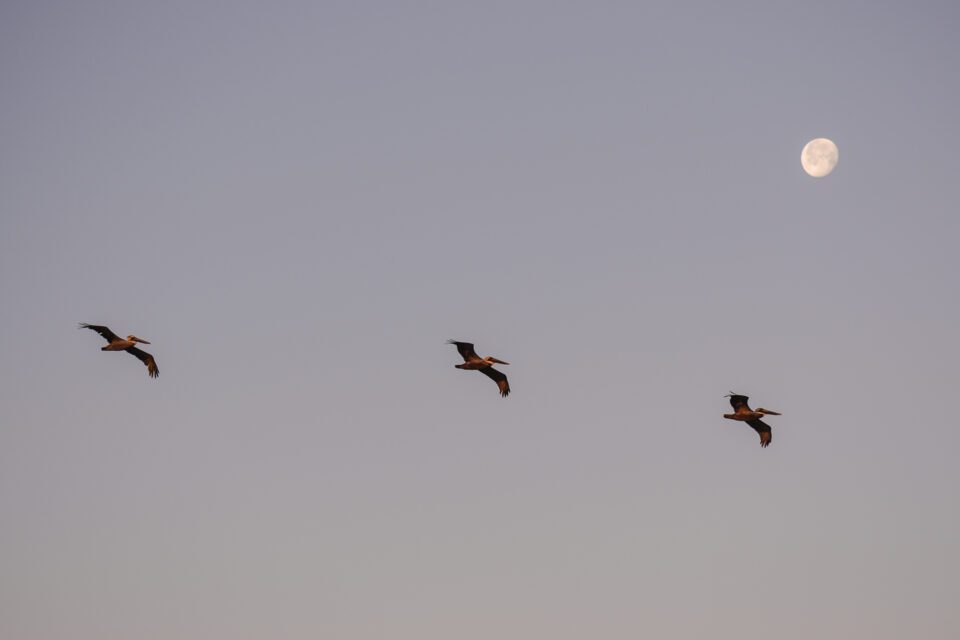 NIKON D7000 + 105mm f/2.8 @ 105mm, ISO 100, 1/320, f/3.5
NIKON D7000 + 105mm f/2.8 @ 105mm, ISO 100, 1/320, f/3.5
All of my subjects here have plenty of breathing space.
The same goes if you’re photographing a mountain, and the peak is almost touching the very top of your photograph. In that case, it will draw unwanted attention and potentially demonstrate a sense of carelessness. Instead, it tends to work better if your subjects each have room to stand on their own, unobstructed by anything else in the photo. That helps you send a strong, cohesive message to your viewers.
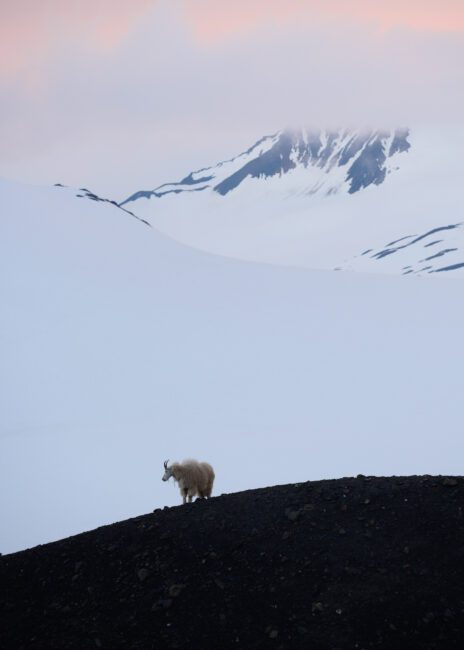 NIKON D800E + 70-200mm f/4 @ 175mm, ISO 200, 1/25, f/5.6
NIKON D800E + 70-200mm f/4 @ 175mm, ISO 200, 1/25, f/5.6
No important object is bunching up against the edge of the frame, and my main subject (the mountain goat) has plenty of breathing space. - مساحة للتنفس
عندما تكون هناك نقاط اهتمام متعددة في الصورة، قد ترغب في منحها “مساحة للتنفس” عن طريق تباعدها عن بعضها البعض. بخلاف ذلك، ستتداخل عناصر صورتك مع بعضها البعض (أو مع حواف إطارك)، مما يؤدي إلى تكوين غير متقن.
فكر في مشهد تحلق فيه بعض الطيور في الهواء، وتريد التقاطها جميعًا في صورة واحدة. ومع ذلك، إذا عبر طائر أمام آخر، ستبدو تلك المنطقة من الصورة فوضوية وغير مقصودة. من الأفضل، بدلاً من ذلك، أن يكون لدى جميع أهدافك مساحة للتنفس – بين بعضها البعض، وبين حواف صورتك.
NIKON D7000 + 105 مم f/2.8 @ 105 مم، ISO 100، 1/320، f/3.5
جميع موضوعاتي هنا لديها مساحة كبيرة للتنفس.وينطبق الشيء نفسه إذا كنت تقوم بتصوير جبل، وكانت قمته تلامس الجزء العلوي من صورتك تقريبًا. في هذه الحالة، فإنه سوف يلفت الانتباه غير المرغوب فيه وربما يظهر شعوراً بالإهمال. وبدلاً من ذلك، يميل الأمر إلى العمل بشكل أفضل إذا كان لدى كل شخص من أهدافك مساحة للوقوف بمفرده، دون أي عائق من أي شيء آخر في الصورة. يساعدك ذلك على إرسال رسالة قوية ومتماسكة إلى مشاهديك.
NIKON D800E + 70-200 مم f/4 @ 175 مم، ISO 200، 1/25، f/5.6
لا يوجد شيء مهم يتجمع على حافة الإطار، وموضوعي الرئيسي (الماعز الجبلي) لديه مساحة كبيرة للتنفس. -
Positive and Negative Space
We’ve already covered positive and negative space, but it bears repeating here.
Positive space is anything in your photo that stands out and attracts attention. Negative space is the opposite — areas of an image that fade into the background and don’t draw the eye. You can take photos with high amounts of negative space, high amounts of positive space, or somewhere in between. They all convey different emotions.
Photographs filled with negative space have a sense of emptiness, peacefulness, and isolation. They tend to be somewhat minimalist images, and they work well when you’re trying to show a sense of scale or loneliness. A single tree in a snowstorm would qualify, and so would the photo below:
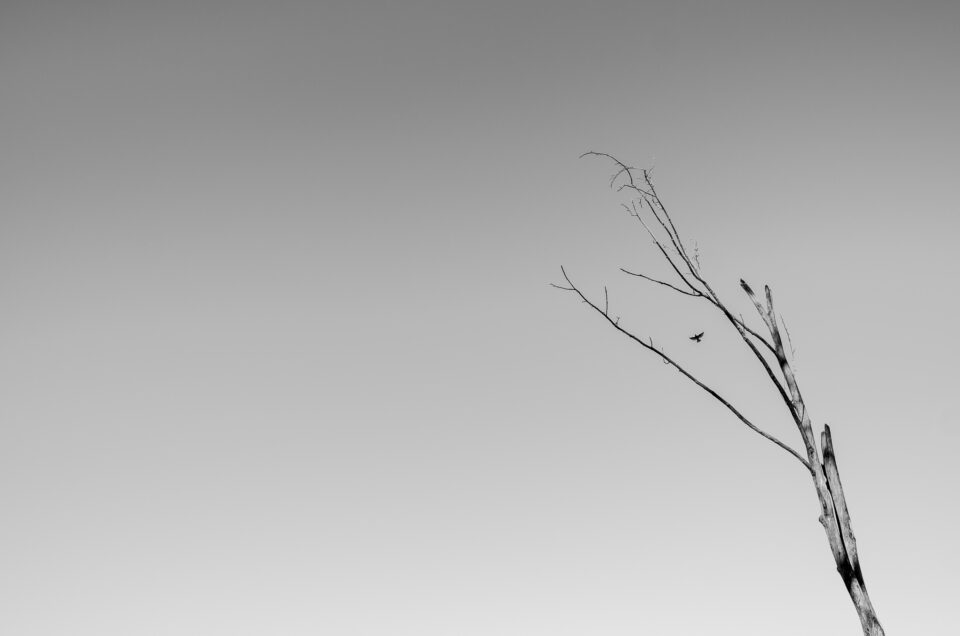 NIKON D7000 + 24mm f/1.4 @ 24mm, ISO 100, 1/640, f/4.0
NIKON D7000 + 24mm f/1.4 @ 24mm, ISO 100, 1/640, f/4.0
Because of all the negative space, this image conveys a sense of isolation.
Photos with a lot of positive space are more intense, busy, and active. They include lots of little details for your eye to notice, although the downside is that they can appear crowded — harming the simplicity and clarity of your message — if you aren’t careful.
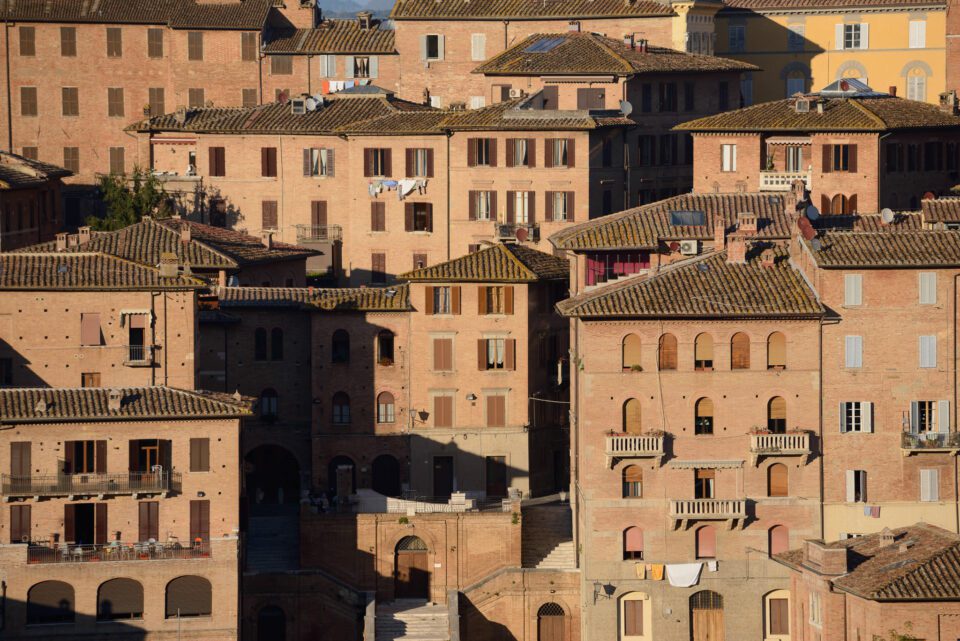 NIKON D800E + 70-200mm f/4 @ 200mm, ISO 100, 1/500, f/6.3
NIKON D800E + 70-200mm f/4 @ 200mm, ISO 100, 1/500, f/6.3
This photo has a lot of positive space, making it feel busier and more active.
These emotions are very important to your composition, and they help form the message that you want to send. If you’re paying close attention in the field, you can move around or adjust your composition in order to alter the ratio of positive space to negative space. Because of the different emotions they convey, this is a great tool to have at your disposal.الفضاء الإيجابي والسلبيلقد تناولنا بالفعل المساحة الإيجابية والسلبية، ولكن الأمر يستحق التكرار هنا.
المساحة الإيجابية هي أي شيء في صورتك يبرز ويجذب الانتباه. المساحة السلبية هي عكس ذلك – مناطق الصورة التي تتلاشى في الخلفية ولا تجذب العين. يمكنك التقاط صور بكميات كبيرة من المساحة السلبية، أو كميات كبيرة من المساحة الإيجابية، أو في مكان ما بينهما. كلهم ينقلون مشاعر مختلفة.
الصور المليئة بالمساحة السلبية تعطي إحساسًا بالفراغ والهدوء والعزلة. تميل إلى أن تكون صورًا بسيطة إلى حد ما، وتعمل بشكل جيد عندما تحاول إظهار إحساس بالحجم أو الوحدة. شجرة واحدة في عاصفة ثلجية ستكون مؤهلة، وكذلك الصورة أدناه:
NIKON D7000 + 24 مم f/1.4 @ 24 مم، ISO 100، 1/640، f/4.0
بسبب كل المساحة السلبية، تنقل هذه الصورة إحساسًا بالعزلة.الصور التي تحتوي على مساحة إيجابية كبيرة تكون أكثر كثافة وانشغالًا ونشاطًا. وهي تشتمل على الكثير من التفاصيل الصغيرة التي يجب أن تلاحظها عيناك، على الرغم من أن الجانب السلبي هو أنها قد تبدو مزدحمة – مما يضر ببساطة رسالتك ووضوحها – إذا لم تكن حذرًا.
NIKON D800E + 70-200 مم f/4 @ 200 مم، ISO 100، 1/500، f/6.3
تحتوي هذه الصورة على الكثير من المساحة الإيجابية، مما يجعلها أكثر انشغالًا ونشاطًا.هذه المشاعر مهمة جدًا لتكوينك، وتساعد في تكوين الرسالة التي تريد إرسالها. إذا كنت تولي اهتمامًا وثيقًا بالميدان، فيمكنك التحرك أو ضبط التكوين الخاص بك لتغيير نسبة المساحة الإيجابية إلى المساحة السلبية. ونظرًا للمشاعر المختلفة التي ينقلونها، فهذه أداة رائعة لتكون تحت تصرفك.
Patterns and RelationshipsIn some cases, with care, you can capture photos that have more intricate patterns and relationships than just a simple composition. For example, you might photograph a landscape with an orange flower in the foreground, and orange light on distant hills. Or, you could capture a plume of smoke rising from a volcano at night, and matching with the shape of the Milky Way overhead.
There’s no end to the world of deeper relationships that are possible in photography. It’s not something you’ll find all the time, but you should keep an eye out. When a photo has an especially imaginative relationship, it will feel completely interconnected and intentional.
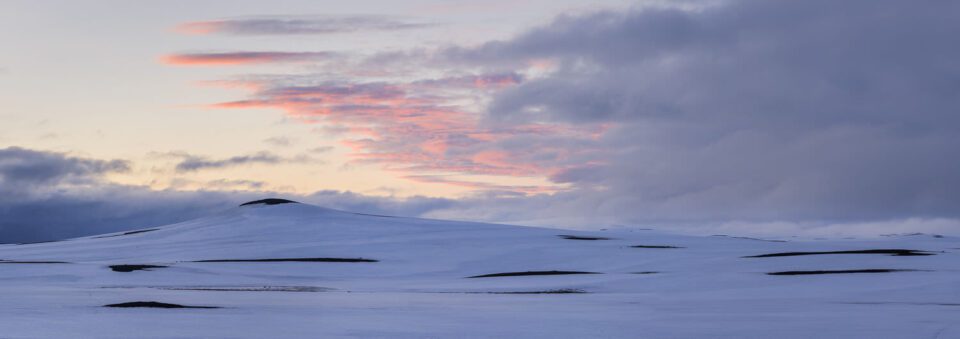 The shape of the rocks on this hill are quite similar to the shape of the clouds — long, thin lines. That makes the top and bottom portions of the photo feel more interconnected, even subconsciously, which gives this photo a stronger “reason to be.”الأنماط والعلاقات
The shape of the rocks on this hill are quite similar to the shape of the clouds — long, thin lines. That makes the top and bottom portions of the photo feel more interconnected, even subconsciously, which gives this photo a stronger “reason to be.”الأنماط والعلاقاتفي بعض الحالات، وبعناية، يمكنك التقاط صور تحتوي على أنماط وعلاقات أكثر تعقيدًا من مجرد تكوين بسيط. على سبيل المثال، يمكنك تصوير منظر طبيعي به زهرة برتقالية في المقدمة وضوء برتقالي على التلال البعيدة. أو يمكنك التقاط عمود من الدخان يتصاعد من البركان ليلاً، ويتطابق مع شكل مجرة درب التبانة في الأعلى.
ليس هناك نهاية لعالم العلاقات الأعمق التي يمكن تحقيقها في التصوير الفوتوغرافي. إنه ليس شيئًا ستجده طوال الوقت، ولكن يجب أن تراقبه. عندما تكون للصورة علاقة خيالية بشكل خاص، ستشعر بأنها مترابطة ومتعمدة تمامًا.
شكل الصخور الموجودة على هذا التل يشبه إلى حد كبير شكل السحب – خطوط طويلة ورفيعة. وهذا يجعل الأجزاء العلوية والسفلية من الصورة تبدو أكثر ترابطًا، حتى دون وعي، مما يمنح هذه الصورة “سببًا أقوى لوجودها”.

